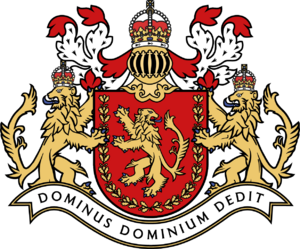Home Service (Great Nortend)
This article is incomplete because it is pending further input from participants, or it is a work-in-progress by one author. Please comment on this article's talk page to share your input, comments and questions. Note: To contribute to this article, you may need to seek help from the author(s) of this page. |
| Home Service | |
|---|---|
 | |
| Active | 8 June 1936 — |
| Country | |
| Role | Civil and military defence |
The Home Service is the voluntary land reserve branch of the Royal Army of Great Nortend. It is tasked with supporting the regular army in the defence of the Realm as well as response in civil emergencies such as fires, floods, storms and riots. The Home Fleet is the naval equivalent. Home servicemen are generally obliged to attend weekly parade nights and up to a fortnight of training exercises annually. They also are on call throughout the week for response to emergencies. Home servicemen cannot be deployed abroad in combatant roles and are thus nicknamed the “Marching Boys”. They are distinct from the officer reserves, in the various corps.
Organisation
The Home Service is organised at a local platoon level. Several platoons from a particular region are grouped together as a company, and often undertake exercises together. Several companies form a militia battalion, which is a county-sized formation.
History
The assent to the Defence of the Realm Act 34 Edm. IX established the modern-day Home Service. The Act combined the former locally raised militias, yeomanries and volunteer corps, which was placed under the command of the War Office. In so doing, the yeomanry and volunteers lost their distinct identity and role, being subsumed in the infantry militias.
21st century
The Home Service shifted its focus after the 2007 Whenton Report back to its original principles of local military and civil defence after a slow decline in their military role leading to some platoons even regularly leaving rifles at home. Since 2008, Home Service companies have participated in regular major exercises domestically and abroad. Furthermore, they retain their on-going responsibility for the defence of critical local infrastructure such as water works, gas plants and electricity mills, as well as response in emergency scenarios such as fire, severe flooding, snowfall, storms, riot or invasion.
Training
The Home Service is often the first responders to civil emergencies such as fire, flooding and storms. For instance, servicemen are trained to use and operate hydrants and fire engines when professional firemen have yet to arrive.
Personnel
Home Service units have a wide mix of ages, from young men fresh out of muster service to retired ex-soldiers. After compulsory muster, there is the option of continuing in the Home Service. Those who do not join immediately after muster service may join up later on, and many retired ex-soldiers also volunteer as home servicemen. Those exempt from muster, such as farm labourers, also often join up as home servicemen, although manual labourers do not usually remain in the Home Service for very many years owing to the nature of their work.
Home servicemen normally wear duty dress or field dress. Uniforms have shoulder patches with the words, “Home Service”. Field dress uniforms additionally have platoon, company and battalion patches whilst duty dress uniforms have arm-bands with the same information.
Home servicemen are paid according to rank and branch, starting at £1/1/- per full day served, and up to 10 shillings per drill night for a private.
Requirements
A person is required to fulfil the following criteria to be eligible to join the Home Service.
- Full Erbonian subjectship.
- Between 17 and 50.
- Of sound and sobre character.
- Physically able.
- Military disposition.
- Of the Church of Nortend.
There is no maximum age limit for service; however, a home serviceman will be forced to retire or leave if he fails to maintain sufficient physical ability to service in the Home Service. A home serviceman must also fulfil his obligations to the Home Service.
This page is written in Erbonian English, which has its own spelling conventions (colour, travelled, centre, realise, instal, sobre, shew, artefact), and some terms that are used in it may be different or absent from other varieties of English. |
